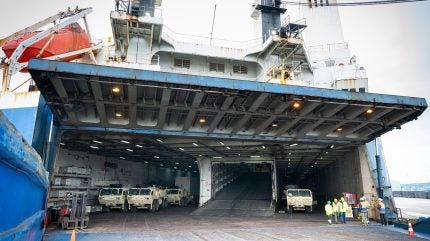
The US Army have unloaded hundreds of armoured vehicles at the Dutch ports of Vlissingen and Eemshaven on 30 October 2024.
Many of the platforms, sitting in more than 2,000 containers, are bound for Poland.

Discover B2B Marketing That Performs
Combine business intelligence and editorial excellence to reach engaged professionals across 36 leading media platforms.
A grand logistical vision, this endeavour among Nato partner nations will make use of a military transport corridor – via road and rail – spanning across Western and Central Europe.
This infrastructure was first established in accordance with an agreement struck in February this year between countries through which the Corridor passes, namely Germany, the Netherlands and Poland.
Since Russia’s annexation of Crimea in 2014, and later in response to their full-scale invasion of Ukraine in 2022, Nato increased its troop presence in Eastern Europe as a deterrent. Reinforcements must reach the Eastern Flank at pace when exercises, operations and in the event of threats occur.
As the lead coordinator for the Corridor and the host nation, the Netherlands have committed to assisting US units in this military mobility mission. Notably, it is the first time that foreign material has arrived at the Eemshaven port.

US Tariffs are shifting - will you react or anticipate?
Don’t let policy changes catch you off guard. Stay proactive with real-time data and expert analysis.
By GlobalDataSome of the wheeled vehicles will travel in convoy from Eemshaven to Germany. This is done under the escort of the Royal Marechaussee – a police force and branch of the Dutch Armed Forces.

The logistical task will take three weeks in all, from 30 October until the 20 November, according to a press release issued by the Dutch government.
Army Technology has contacted the Dutch Ministry of Defence and the Polish Ministry of National Defence regarding further details of the logistical plan and what Polish units will operate the vehicles but neither organisation responded at the time of publishing.
Kitting out the Eastern Flank
Poland has ascended as a strategic partner to the US and Nato since the onset of the Russian invasion of Ukraine nearly three years ago. The transfer of hundreds of armoured vehicles demonstrates the significance of the country’s presence on the Eastern Flank and the need to bolster its capabilities there.
While the transportation of hundreds of armoured vehicles to Poland is a demanding task, we need only look to the Russia-Ukraine war to see that this large number of platforms is a fleeting figure in a high intensity warfare environment.
On 1 November, the Ukrainian Ministry of Defence revealed that the losses of Russian armoured fighting vehicles reached 923 units in the whole of October 2024.
“It’s the highest monthly number since the beginning of the invasion,” according to an X post. “On average, Ukrainian warriors destroyed 30 [platforms] every day.”
US and Poland defence cooperation
The Central European republic’s relatively new posture hinges on its thriving military expansion. According to Chatham House, Poland is spending 4% of its GDP on defence while few others in the North Atlantic alliance are beyond straddling the 2% benchmark set in 2014.
On October 30, the UK government unveiled its autumn budget in which it has yet to reach its own aspirational target of 2.5%. Content to inch closer to an arbitrary target that, if ever reached, will actually have little impact on Britain’s military readiness. All the while some analysts anticipate the need to be ready to fight the Russians by 2028.
A newly appointed member of the UK Defence Select Committee, a Liberal Democrat MP, Mike Martin, recently expressed his view on the social media platform X that attention must be given to Russia as the primary strategic threat to Britian and Europe.
“You wouldn’t know this from the House of Commons where a lot of time is spent debating the Middle East,” he commented while still highlighting the relative importance of the conflict.
Nevertheless, Poland is preparing in the medium- to long-term for the prospect that the US will pull out of Europe and pivot towards the Indo-Pacific where they face growing aggression from China.
In the meantime, Poland is securing offset agreements and licences to build US equipment and platforms domestically, and to shore up its military infrastructure should Nato enter the conflict in Eastern Europe.
At present, the US has military units stationed in Poland which they rotate every few months. This time, the 3rd Armored Brigade Combat Team of the 1st Armored Division is rotating in. There is also an interwoven military structure when we consider the V Corps, or Fifth Corps, a Polish-led unit comprised of American soldiers based in Poznan.





